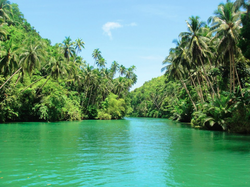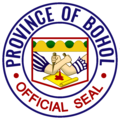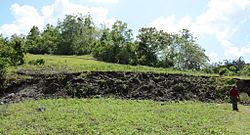Bohol (island)
Bohol is the tenth-largest island of the Philippines and the main island of the Bohol province. It is part of the Region VII (Central Visayas) in the Visayas island group.
|
(from top: left to right) Chocolate Hills, Loboc River, Panglao Island, Alona Beach, and Bohol Provincial Capitol in Tagbilaran. | |
| Anthem: Awit sa Bohol (Bohol Hymn)[1] | |
| {{safesubst:#property:P242}} Location in the Philippines | |
OpenStreetMap Lua error in Module:Infobox_mapframe at line 118: attempt to index field 'wikibase' (a nil value). | |
| Coordinates: Lua error in Module:Coordinates at line 614: attempt to index field 'wikibase' (a nil value). | |
| Region | {{safesubst:#property:P131}} |
| Discovered by the Spanish | March 25, 1565 |
| Founded | July 22, 1854 |
| Government | |
| • Governor | Erico Aristotle C. Aumentado |
| • Vice Governor | Dionisio Victor A. Balite |
| • Legislature | Bohol Provincial Board |
| Highest elevation (Mount Matunog) | 864 m (2,835 ft) |
| Population (?) | |
| • Rank | 20th out of 81 |
| • Language | |
| Divisions | |
| • Independent cities | 0 |
| • Component cities | 1
|
| • Municipalities | 47
|
| • Districts | List
|
| Time zone | UTC+08:00 (PST) |
| ZIP code | {{safesubst:#property:P281}} |
| ISO 3166 code | {{safesubst:#property:P300}} |
| Income class | {{s class |
| PSGC | [https://psa.gov.ph/classification/psgc/?q=psgc/barangays/{{#pro000®code={{&provcode=
|
| Website | http://{{safesubst:#property:P856}} |
The Philippine Tarsier, one of the smallest primate in the world, is one endemic animal of southern Philippines, including the island of Bohol.
Geography
The island of Bohol has an oval shape and is surrounded by 73 smaller islands; the larger of these small islands are Panglao, in the southwest in front of the city of Tagbilaran, and Lapining, in the northeast.
The main island of Bohol has an area of 3,269 km2 (1,262 sq mi) and a coastline of 261 km (162 mi). It lies southeast from Cebu Island across the Cebu Strait (sometimes called Bohol Strait) and southwest from Leyte, separated by the Camotes Sea and Canigao Channel. Bohol is also located north of Mindanao with the Bohol Sea or Mindanao Sea between them.
The terrain of Bohol is basically hilly and about half the island is covered in limestone. The interior is a large plateau.
In the centre of the island, mainly in the municipalities of Sagbayan, Batuan and Carmen, are the Chocolate Hills, over 1,270 hills cone-shaped hills over an area of 50 km2 (19 sq mi).[2]
The main mountain range of the island is Sierra Bullones that is along the south coast. It begins near Loboc, goes to the east and then to the northeast to end near Candijay. The highest point of this range and in the entire province is Mount Mayana (870 m or 2,854 ft).[3]
Rivers
There are four main rivers that flow through Bohol:
- Loboc flows from the centre of the island to the southeastern coast.
- Inabanga, the largest river of the island, runs in the northwestern part of the province.
- Abatan flows in the southwest; and
- Ipil river flows in the north.
Climate
The climate of the island of Bohol is a warm tropical climate (Köppen climate classification Af); it is typically hot and wet throughout the year and rainfall is both heavy and frequent.[4]
Gallery
River cruise on the Loboc River
Bohol (island) Media
Official Boholano version Awit sa Bohol (1974) translated by Maxelende Ganade
Clarin Ancestral House interior in Loay
The Chocolate Hills of Bohol
Old Provincial Capitol of Bohol in Tagbilaran
The Loboc River cruise is one of the popular tourist attractions in the island.
References
- ↑ Hellingman 2002a.
- ↑ "Chocolate Hills". The Seven Natural Wonders. Archived from the original on 26 November 2013. Retrieved 18 November 2013.
- ↑ "Overview". Bohol - The Island Province. Archived from the original on 5 March 2023. Retrieved 18 November 2013.
- ↑ "Tagbilaran, Philippines - Köppen Climate Classification". Weatherbase. Retrieved 18 November 2013.
Related pages
Other websites
| Wikimedia Commons has media related to Lua error in Module:Commons_link at line 62: attempt to index field 'wikibase' (a nil value).. |
- Visayan Silent Gardens - Bohol Island Archived 2013-11-10 at the Wayback Machine
- Bountiful Bohol Archived 2013-07-20 at the Wayback Machine
- Bohol, Philippines - Tourism informations


















